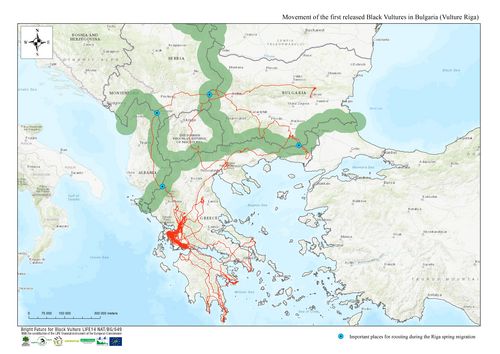Vultures know no borders
The last remaining population of around 30-35 breeding pairs of Cinereous Vultures (Aegypius monachus) on the Balkan Peninsula can be found in the Dadia-Lefkimi-Soufli Forest National Park in Greece, right in the Balkan Green Belt. In 2018 the project “Vulture Back to LIFE” initiated the reintroduction of the species in Bulgaria. On 16 August 2018 the project team released the first three juvenile Cinereous Vultures, tagged with GPS transmitters to monitor their movements. The data from all three birds show us that vulture conservation requires coordinated efforts across borders.

The most emblematic of the three vultures stories is Riga‘s. Riga headed north from its wintering grounds, traveling 257 km in one day. The following day it passed through Albania. Riga spent the night in Prizen in Kosovo at the Balkan Green Belt before continuing its journey back to Bulgaria. He was spotted in the Uvac Special Nature Reserve in Serbia and spent the night in the company of the Griffon Vultures of the area. After that the young vulture chose another site within the Balkan Green Belt - Stara Planina Mountain on the border between Bulgaria and Serbia. At the end of April Riga travelled to the Western Rhodope Mountains in Bulgaria obviously visiting one of the country‘s most popular resorts. After that he headed to the eastern parts of the Rhodope Mountains, also at the Balkan Green Belt. On 28 April the bird travelled towards the Greek border before returning to the Rhodope Mountains. After that the bird stayed near the Pindos Mountain close to a colony of griffon vultures.
The travels of this young vulture through the Balkan Peninsula illustrates that vultures know no borders and that their successful conservations depends on the mutual actions of all countries across the region to tackle the threats they are facing such as illegal wildlife poisoning. It also shows us that vultures are attracted to regions with a preserved biological diversity, such as the European Green Belt - proving once again the importance of the European Green Belt Initiative and the need to jointly preserve these unique regions.
Тhe project “Vulture Back to LIFE” (LIFE14 NAT/BG/649) unites the efforts of five international partners: Green Balkans – Stara Zagora and Fund for Wild Flora and Fauna (FWFF) from Bulgaria, Vulture Conservation Foundation (VCF) from the Netherlands, Junta de Extremadura from Spain and EuroNatur from Germany.
Visit the project’s website here
